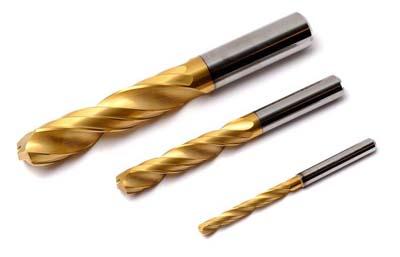
Seco Tools has announced the release of its new Feedmax -N family of solid carbide drills for high performance drilling in aluminum and non-ferrous materials. Developed in cooperation with manufacturers in the aerospace industry, -N drills feature a geometry that is wider and deeper than standard drills to improve chip flow and evacuation. The tools' coating has a lower silicon (Si) content to effectively machine aluminum with less than 10 percent Si, in addition to brass, zinc and magnesium.
Cost savings are achieved through increased output and reliability, as well as fewer de-burring issues. The -N geometry features a conical front clearance with a 12 degree relief angle and 140 degree point angle, with narrow land margins that are 40 percent thinner than standard drills to reduce friction and edge buildup.
The drills also have an increased back taper for axial relief. Seco Tools' optimized edge preparation provides for light cutting and less stress. For best results, -N drills should be used with Shrinkfit holders or hydraulic chucks and internal coolant. The new tools are available in diameters ranging from 0.1" to 0.551", with a 3xD drilling depth.
Contact Details
Related Glossary Terms
- clearance
clearance
Space provided behind a tool’s land or relief to prevent rubbing and subsequent premature deterioration of the tool. See land; relief.
- coolant
coolant
Fluid that reduces temperature buildup at the tool/workpiece interface during machining. Normally takes the form of a liquid such as soluble or chemical mixtures (semisynthetic, synthetic) but can be pressurized air or other gas. Because of water’s ability to absorb great quantities of heat, it is widely used as a coolant and vehicle for various cutting compounds, with the water-to-compound ratio varying with the machining task. See cutting fluid; semisynthetic cutting fluid; soluble-oil cutting fluid; synthetic cutting fluid.
- edge preparation
edge preparation
Conditioning of the cutting edge, such as a honing or chamfering, to make it stronger and less susceptible to chipping. A chamfer is a bevel on the tool’s cutting edge; the angle is measured from the cutting face downward and generally varies from 25° to 45°. Honing is the process of rounding or blunting the cutting edge with abrasives, either manually or mechanically.
- land
land
Part of the tool body that remains after the flutes are cut.
- point angle
point angle
Included angle at the point of a twist drill or similar tool; for general-purpose tools, the point angle is typically 118°.
- relief
relief
Space provided behind the cutting edges to prevent rubbing. Sometimes called primary relief. Secondary relief provides additional space behind primary relief. Relief on end teeth is axial relief; relief on side teeth is peripheral relief.

